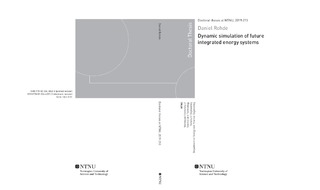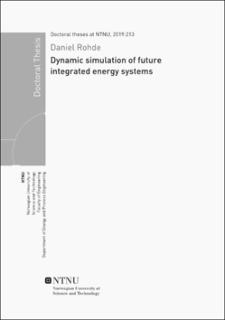| dc.contributor.advisor | Nord, Natasa | |
| dc.contributor.advisor | Andresen, Trond | |
| dc.contributor.author | Rohde, Daniel | |
| dc.date.accessioned | 2020-01-29T07:41:42Z | |
| dc.date.available | 2020-01-29T07:41:42Z | |
| dc.date.issued | 2019 | |
| dc.identifier.isbn | 978-82-326-4023-2 | |
| dc.identifier.issn | 1503-8181 | |
| dc.identifier.uri | http://hdl.handle.net/11250/2638444 | |
| dc.description.abstract | The building sector is responsible for a large part of the world's total energy use. More than half of building energy use is needed for space heating, domestic hot water heating, and space cooling. Thermal energy supply systems are used to cover these thermal energy demands and are an integral part of new buildings and neighborhoods. These systems are becoming increasingly more complex due to the inclusion of renewable energy sources and thermal storages. Advanced simulations are required to analyze the design and the operation of these complex systems in detail and are thus an important part of the transition to new and improved building energy systems.
In this work, component and system models for thermal energy supply systems were developed in the modeling language Modelica. Numerical efficiency was an important part of the development process because the aim was to analyze long periods of time. In addition, the different requirements for simulation and optimization had to be considered during model development. Detailed description of all the developed Modelica models are given in this thesis. The models were used for dynamic simulations with Dymola as well as dynamic optimizations with JModelica.org, of which the latter proved to be more challenging. The optimization approach is therefore also described in detail in this thesis.
The design and the operation of two case study systems were analyzed in this work: 1) an existing integrated heating and cooling system at Vulkan, Oslo and 2) a planned local district heating grid at Brøset, Trondheim. The main components of the integrated heating and cooling system at Vulkan were heat pumps, plate heat exchangers, flat plate solar collectors, water storage tanks, ice thermal energy storage, and borehole thermal energy storage. The system supplied a total floor area of 38 500 m2 and is described in detail in this thesis. The main components of the local district heating grid at Brøset were a heat central, distribution pipes, and customer substations. The system was assumed to supply a total floor area of 178 000 m2 and the different system design concepts that were analyzed are described in this thesis.
The main focus of this work was the case study system at Vulkan. The simulation results showed that the current operation of this system might be unsustainable due to an unbalanced long-term storage. Sustainable operation was possible in the simulations by increasing the number of solar collectors or the amount of imported heat from the district heating grid. The optimization results showed that variable setpoints for the heating and cooling supply temperatures could reduce the electricity use of the system. However, this would require the implementation of an advanced control system. The installation of larger storage tanks combined with optimal control was also investigated. It was shown that this combination could reduce the electricity costs of the system. However, the savings were not large enough to make an installation seem profitable with the current pricing scheme. Higher peak load tariffs and/or an increased variability of the electricity price might change this conclusion in the near future.
The analyses of the different system design concepts for the local district heating grid at Brøset showed that low-temperature grids were more environmentally-friendly than high-temperature-grids. This was mainly due to lower heat losses in the grid and the ability to include waste heat sources. The diameters of the district heating distribution pipes were shown to be important for the heat losses of the pipes and the required pumping power.
Several Modelica libraries with similar component models as the ones presented in this thesis are available. However, the system model development and the dynamic optimizations proved to be the most challenging tasks in this work. These tasks require a rather high level of user experience, but are expected to be increasingly important in the near future. This prediction is supported by the coordinated efforts that are currently going on in the IBPSA Project 1, which has a scope similar to the one of this thesis. | nb_NO |
| dc.language.iso | eng | nb_NO |
| dc.publisher | NTNU | nb_NO |
| dc.relation.ispartofseries | Doctoral theses at NTNU;2019:213 | |
| dc.relation.haspart | Paper 1: Rohde, Daniel; Bantle, Michael; Andresen, Trond; Nord, Natasa. Documentation of an integrated thermal energy system for a building complex. I: Proceedings of the 24th International Congress of Refrigeration. International Institute of Refrigeration 2015 ISBN 978-2-36215-012-8. s.
https://doi.org/10.18462/iir.icr.2015.0445 | nb_NO |
| dc.relation.haspart | Paper 2: Rohde, Daniel; Andresen, Trond; Nord, Natasa. Interaction Between a Building Complex with an Integrated Thermal Energy System and a District Heating System. I: CLIMA 2016 - proceedings of the 12th REHVA World Congress: volume 3. Aalborg: Aalborg University | nb_NO |
| dc.relation.haspart | Paper 3: Kauko, Hanne; Kvalsvik, Karoline Husevåg; Rohde, Daniel; Hafner, Armin; Nord, Natasa. Dynamic modelling of local low-temperature heating grids: A case study for Norway. Energy 2017 ;Volum 139. s. 289-297
http://dx.doi.org/10.1016/j.energy.2017.07.086 | nb_NO |
| dc.relation.haspart | Paper 4: Kauko, Hanne; Kvalsvik, Karoline Husevåg; Rohde, Daniel; Nord, Natasa; Utne, Åmund. Dynamic modeling of local district heating grids with prosumers: A case study for Norway. Energy 2018 ;Volum 151. s. 261-271
https://doi.org/10.1016/j.energy.2018.03.033 | nb_NO |
| dc.relation.haspart | Paper 5: Rohde, Daniel; Andresen, Trond; Nord, Natasa. Analysis of an integrated heating and cooling system for a building complex with focus on long–term thermal storage. Applied Thermal Engineering 2018 ;Volum 145. s. 791-803
https://doi.org/10.1016/j.applthermaleng.2018.09.044 | nb_NO |
| dc.relation.haspart | Paper 6: Rohde, Daniel; Knudsen, Brage Rugstad; Andresen, Trond; Nord, Natasa. Dynamic optimization of control setpoints for an integrated heating and cooling system with thermal energy storages. Energy 2019 ;Volum 193.
https://doi.org/10.1016/j.energy.2019.116771
Attribution 4.0 International (CC BY 4.0) | nb_NO |
| dc.title | Dynamic simulation of future integrated energy systems | nb_NO |
| dc.type | Doctoral thesis | nb_NO |
| dc.subject.nsi | VDP::Technology: 500::Environmental engineering: 610 | nb_NO |

